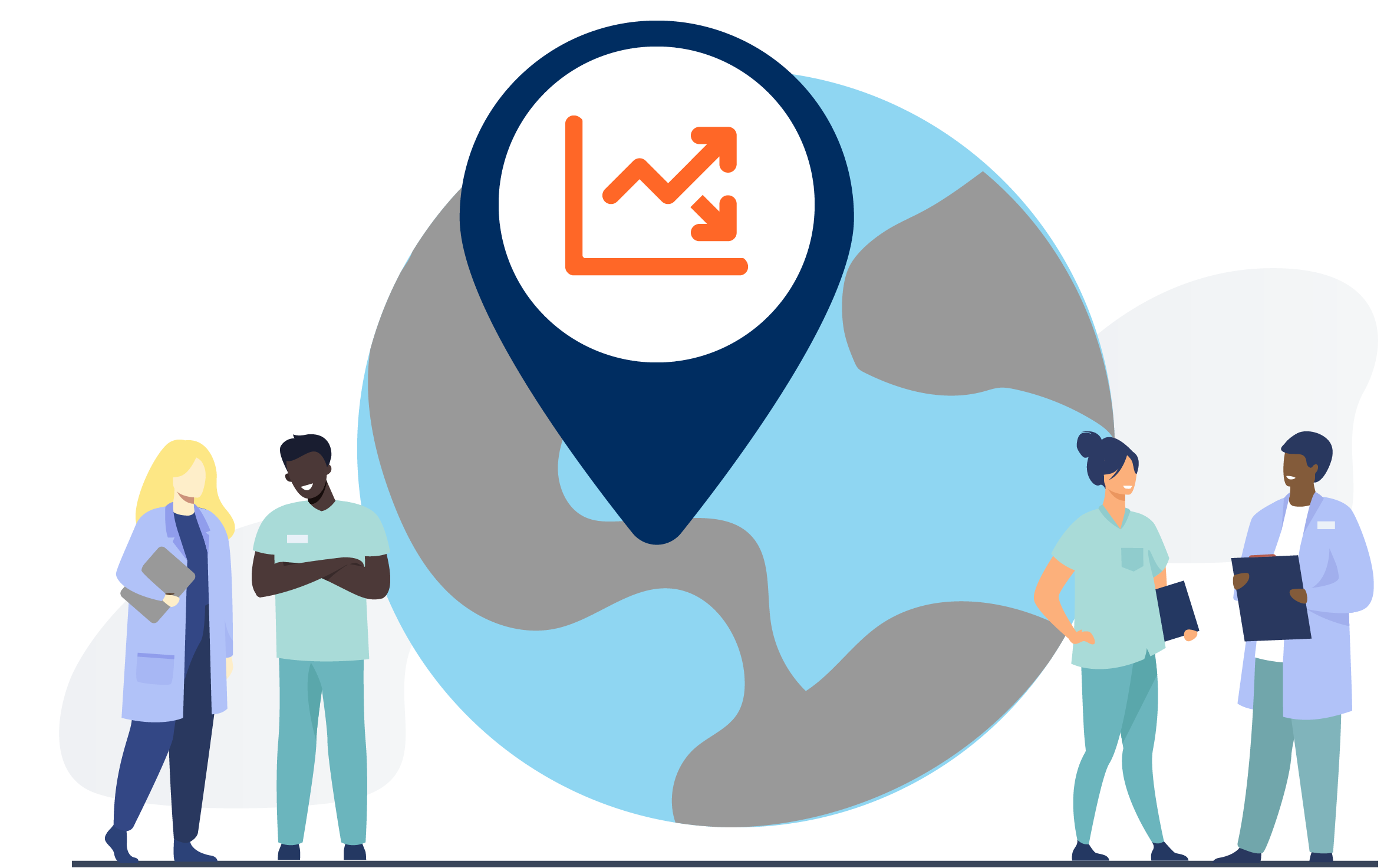We’ve all just lived through a pandemic. A global, life-changing, system-changing pandemic. Outside of world-wide conflict, it’s hard to think of something other than communicable diseases that have such a direct impact on the global population. Historically, the field of global health emerged from the study of “tropical diseases”—mostly infectious in nature that were of interest to doctors and researchers in the “global north” and were more prevalent in tropical and resource-poor areas (an early basis for colonialism in global health). The HIV epidemic turned a sharp focus on infectious diseases around the globe with efforts to intervene to stop the spread and save lives. So for decades, communicable diseases—especially the “Big 3”: HIV, Malaria, and Tuberculosis—have been a target for large- and small-scale interventions and are heavily represented in international development goals. This is concurrent to the work done to improve illness and death due to respiratory and diarrheal diseases (predominantly affecting children). And there remains a group of uncommon “Neglected Tropical Diseases” that are caused by infectious diseases that, of course, disproportionately affect the poorest communities and are “neglected” in that there has been little meaningful progress in diagnostic, treatment, and control efforts over the years. Overall, there have been major improvements (though far from anything that looks like eradication) in morbidity and mortality due to communicable diseases worldwide.
This is a very large topic. And I am an infectious disease specialist, so of course I’d love to discuss everyone of these diseases with you in detail! But, more importantly, this module is intended to help you frame the role of communicable diseases within the context of global health—understanding the “Big 3” outside of what board review materials cover or U.S.-based recommendations for diagnosis and treatment. And the COVID pandemic has called more attention to the need to look forward to coming threats. A widely recognized threat with global impact that has emerged as a global health priority is antimicrobial resistance. For students hoping to spend more time in tropical infectious diseases, emerging infectious diseases, and NTDs, additional resources are provided at the end of the module.
Learning objectives
- Review the costs, consequences, and burden of communicable diseases globally
- Review key concepts in epidemiology, prevention, and treatment of indicator communicable diseases and compare with familiar epidemiology and approaches to prevention and treatment of them in the United States
- Describe characteristics of successful interventions and key barriers to prevention and control of communicable diseases
- Describe the burden of antimicrobial resistance globally and discuss contributing determinants
Pre-module prompt
Before you start this module:
-
-
In sub-saharan Africa, which sub-group is most affected by HIV/AIDS?
-
Speculate: Historically poverty, war, and poor sanitation were the strongest determinants of transmission and morbidity/mortality due to infectious diseases. As more and more of the world achieves improvements in economic status, basic sanitation, and (relative) peace, what do you think will be drivers of infectious diseases in the next 50–100 years?
-
- Read
- Watch
- Reflect
-
Global Health 101, Chapter 13: Communicable Diseases.
This chapter may be a review of information you have learned before. It is written from a public health perspective, and so is worth a skim to gain some familiarity with the data used to measure the burden of communicable diseases in global health, a partial view of these diseases from a non-U.S. lens, and context of the most important infectious diseases in global health (which are differently prioritized than infectious diseases within the U.S. healthcare system).
-
Complete the following Global Health eLearning Center modules, including the knowledge assessments and send screen shot/certificate of completion to course director:
- Global Trends in HIV/AIDS. YouTube. (Used with permission from Vanderbilt Institute for Global Health.)
- Ramanan Laxminarayan: The coming crisis in antibiotic resistance.
On the Slack discussion board:
-
For country of interest:
-
Evaluate the burden of disease for the "Big Three"—TB, HIV, Malaria. What is incidence/prevalence, and what are key challenges facing the control of these infections specific to the country of interest?
-
What organizations are involved in efforts to improve control/treatment/prevention of these diseases?
-
-
For country of interest:
-
Are antibiotics available for purchase without a prescription?
-
What surveillance is in place (if any) for antimicrobial resistance?
-
Can you find evidence of any campaigns targeting AMR awareness?
-
Additional resources
- The Big 3
- Emerging infectious diseases
- Neglected tropical diseases
- A social movement to fight AIDS, malaria, and TB and end the epidemics. Mark Dybul at TEDxAmRing.
- Anthony S. Fauci and Ambassador Deborah L. Birx on global HIV/AIDS outlook (2017).
- Keiser J, Singer BH, Utzinger J. Reducing the burden of malaria in different eco-epidemiological settings with environmental management: a systematic review. Lancet Infect Dis. 2005;5(11):695–708. doi:10.1016/S1473-3099(05)70268-1
- Praet N, Asante KP, Bozonnat MC, et al. Assessing the safety, impact and effectiveness of RTS,S/AS01E malaria vaccine following its introduction in three sub-Saharan African countries: methodological approaches and study set-up. Malar J. 2022;21(1):132. Published 2022 Apr 25. doi:10.1186/s12936-022-04144-3
- Global Tuberculosis Report. WHO 2022.
- Babbage Podcast. The pandemic shattered global efforts to control tuberculosis, which was the most lethal infectious disease in the world until covid-19 took its crown. Now, with deaths rising, TB is set to reclaim that dubious honour. But the covid era also holds important lessons for the fight against TB. Can innovations such as genomic sequencing facilities and new vaccine technologies be applied to TB care, too?
- McMichael AJ, Woodruff RE, Hales S. Climate change and human health: present and future risks [published correction appears in Lancet. 2006 Sep 2;368(9538):842]. Lancet. 2006;367(9513):859-869. doi:10.1016/S0140-6736(06)68079-3
- Soneja S, Tsarouchi G, Lumbroso D, Tung DK. A Review of Dengue's Historical and Future Health Risk from a Changing Climate. Curr Environ Health Rep. 2021;8(3):245–265. doi:10.1007/s40572-021-00322-8
- Sharma V, Sharma M, Dhull D, Sharma Y, Kaushik S, Kaushik S. Zika virus: an emerging challenge to public health worldwide. Can J Microbiol. 2020;66(2):87–98. doi:10.1139/cjm-2019-0331
- Gupta S, Gupta N, Yadav P, Patil D. Ebola virus outbreak preparedness plan for developing Nations: Lessons learnt from affected countries. J Infect Public Health. 2021;14(3):293–305. doi:10.1016/j.jiph.2020.12.030
- Sasidharan S, Dhillon HS. Ebola, COVID-19 and Africa: What we expected and what we got. Dev World Bioeth. 2021;21(1):51–54. doi:10.1111/dewb.12292
- Kanungo S, Azman AS, Ramamurthy T, Deen J, Dutta S. Cholera. Lancet. 2022 Apr 9;399(10333):1429–1440. doi: 10.1016/S0140-6736(22)00330-0. PMID: 35397865.
- Cholera: resurgence of fatal yet preventable disease. BMJ 2023; 382 doi: https://doi.org/10.1136/bmj.p1831 (published 14 August 2023).
- Hotez PJ. Forgotten People, Forgotten Diseases : the Neglected Tropical Diseases and Their Impact on Global Health and Development. Third edition. ASM Press; 2022. doi:10.1002/9781683673903
- Available as eBook through WSU libraries. This is the single best source of information about the NTDs, the basics about the infections, and strategies and programs used to address them
- Neglected Tropical Diseases and Pandemic Prevention with Peter Hotez. Meet the Microbiologist.
- This is a video-podcast interview with Dr. Peter Hotez who, among infectious disease specialists, is considered the “father of NTDs” with a popular book listed above, Forgotten People, Forgotten Diseases.
- Asundi A, Beliavsky A, Liu XJ, et al. Prevalence of strongyloidiasis and schistosomiasis among migrants: a systematic review and meta-analysis [published correction appears in Lancet Glob Health. 2019 Apr;7(4):e419]. Lancet Glob Health. 2019;7(2):e236–e248. doi:10.1016/S2214- 109X(18)30490-X
- Ichimori K, King JD, Engels D, et al. Global programme to eliminate lymphatic filariasis: the processes underlying programme success. PLoS Negl Trop Dis. 2014;8(12):e3328. Published 2014 Dec 11. doi:10.1371/journal.pntd.0003328

